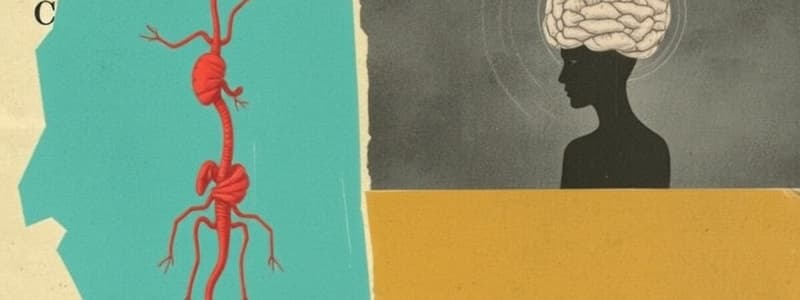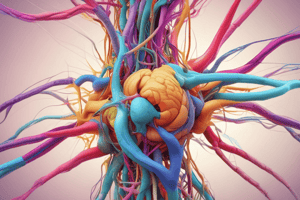Podcast
Questions and Answers
¿Cuál es la función principal del sistema nervioso simpático?
¿Cuál es la función principal del sistema nervioso simpático?
- Regular la temperatura corporal
- Estimular la digestión y la absorción de nutrientes
- Mantener la presión arterial en niveles óptimos
- Respuesta de lucha o huida (correct)
¿Qué neurotransmisor es liberado por las células cromafines en la médula adrenal?
¿Qué neurotransmisor es liberado por las células cromafines en la médula adrenal?
- Serotonina
- Noradrenalina
- Adrenalina (correct)
- Acetilcolina
¿Qué efecto tiene el sistema nervioso simpático sobre la motilidad intestinal?
¿Qué efecto tiene el sistema nervioso simpático sobre la motilidad intestinal?
- Aumento de la motilidad intestinal
- Relajación del músculo liso intestinal
- Disminución de la motilidad intestinal (correct)
- Estímulo de la secreción gástrica
Las neuronas postganglionares del sistema nervioso simpático son conocidas por liberar principalmente:
Las neuronas postganglionares del sistema nervioso simpático son conocidas por liberar principalmente:
¿Cuál de las siguientes afirmaciones es cierta acerca de la vasoconstricción en el contexto del sistema nervioso simpático?
¿Cuál de las siguientes afirmaciones es cierta acerca de la vasoconstricción en el contexto del sistema nervioso simpático?
¿Cuál de las siguientes funciones no es atribuida al sistema nervioso parasimpático?
¿Cuál de las siguientes funciones no es atribuida al sistema nervioso parasimpático?
¿De dónde se origina el sistema nervioso parasimpático?
¿De dónde se origina el sistema nervioso parasimpático?
¿Qué efecto tiene el sistema nervioso parasimpático en la función cardíaca?
¿Qué efecto tiene el sistema nervioso parasimpático en la función cardíaca?
¿Cuál de las siguientes afirmaciones sobre el sistema nervioso parasimpático es incorrecta?
¿Cuál de las siguientes afirmaciones sobre el sistema nervioso parasimpático es incorrecta?
¿Qué función está asociada con la acción del sistema nervioso parasimpático en la función sexual?
¿Qué función está asociada con la acción del sistema nervioso parasimpático en la función sexual?
¿Cuál es el efecto de los receptores M2 en el corazón?
¿Cuál es el efecto de los receptores M2 en el corazón?
¿Qué neurotransmisor es liberado en la sinapsis neuroefectora del neurona postgangliónica?
¿Qué neurotransmisor es liberado en la sinapsis neuroefectora del neurona postgangliónica?
¿Cuál es una de las acciones del receptor muscarínico M3 en el organismo?
¿Cuál es una de las acciones del receptor muscarínico M3 en el organismo?
¿Qué efecto tiene la atropina, un antagonista muscarínico?
¿Qué efecto tiene la atropina, un antagonista muscarínico?
¿Qué receptor muscarínico está asociado con la contracción del músculo detrusor de la vejiga?
¿Qué receptor muscarínico está asociado con la contracción del músculo detrusor de la vejiga?
¿Cuál de las siguientes afirmaciones sobre los receptores nicotínicos N2 es correcta?
¿Cuál de las siguientes afirmaciones sobre los receptores nicotínicos N2 es correcta?
¿Qué neurotransmisor se libera en la sinapsis neuroefectora del sistema simpático?
¿Qué neurotransmisor se libera en la sinapsis neuroefectora del sistema simpático?
¿Cómo actúan los receptores adrenérgicos en el sistema simpático?
¿Cómo actúan los receptores adrenérgicos en el sistema simpático?
¿Qué caracteriza a la transmisión ganglionar en el sistema simpático?
¿Qué caracteriza a la transmisión ganglionar en el sistema simpático?
¿Cuál es la función de las células cromafinas en la médula adrenal?
¿Cuál es la función de las células cromafinas en la médula adrenal?
Flashcards
Parasympathetic Nervous System
Parasympathetic Nervous System
A division of the autonomic nervous system that promotes "rest and digest" responses, influencing functions like digestion, heart rate, and eye focus.
Digestion (parasympathetic)
Digestion (parasympathetic)
Increased intestinal activity, secretions, and glycogen storage stimulated by the parasympathetic nervous system.
Heart Rate (parasympathetic)
Heart Rate (parasympathetic)
The parasympathetic nervous system slows down heart rate (bradycardia).
Pupil Constriction (parasympathetic)
Pupil Constriction (parasympathetic)
Signup and view all the flashcards
Origin of Parasympathetic
Origin of Parasympathetic
Signup and view all the flashcards
Sympathetic Nervous System Location
Sympathetic Nervous System Location
Signup and view all the flashcards
Sympathetic Neurotransmitters
Sympathetic Neurotransmitters
Signup and view all the flashcards
Sympathetic Response: Fight or Flight
Sympathetic Response: Fight or Flight
Signup and view all the flashcards
Sympathetic Response: Pupil Dilation
Sympathetic Response: Pupil Dilation
Signup and view all the flashcards
Sympathetic Response: General Effects
Sympathetic Response: General Effects
Signup and view all the flashcards
Sympathetic Preganglionic NT
Sympathetic Preganglionic NT
Signup and view all the flashcards
Nicotinic Receptor Type
Nicotinic Receptor Type
Signup and view all the flashcards
Neuroeffector NT in Sympathetic
Neuroeffector NT in Sympathetic
Signup and view all the flashcards
Adrenal Medulla NT
Adrenal Medulla NT
Signup and view all the flashcards
Metabotropic Receptor Example
Metabotropic Receptor Example
Signup and view all the flashcards
Parasympathetic Neurotransmitter
Parasympathetic Neurotransmitter
Signup and view all the flashcards
Muscarinic Receptors
Muscarinic Receptors
Signup and view all the flashcards
M2 Receptor Effect
M2 Receptor Effect
Signup and view all the flashcards
M3 Receptor Effect
M3 Receptor Effect
Signup and view all the flashcards
Muscarinic Agonists
Muscarinic Agonists
Signup and view all the flashcards




